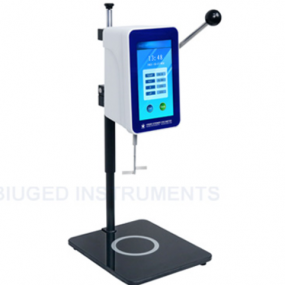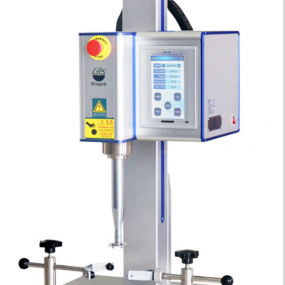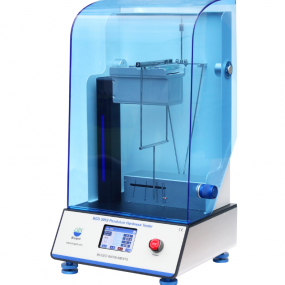BGD 632 Precise Rub Resistance Tester
-
152
-
0765 259 545
Precise Rub Resistance Tester
Model: BGD 632
BGD 632 Precise Rub Resistance Tester is designed and manufactured according to ASTM D 5264 and TAPPI T 830 . It is applicable in abrasion resistance test of printed materials like labels, folding cartons, corrugated boxes, inserts, circulars, and other packaging materials having applied graphics on a flat substrate. It can help users to analyze the affairs of lower abrasion assistance, ink layer falling-off, lower printable of PS boards, and rigidity of coating layers of other products.
Model: BGD 632
BGD 632 Precise Rub Resistance Tester is designed and manufactured according to ASTM D 5264 and TAPPI T 830 . It is applicable in abrasion resistance test of printed materials like labels, folding cartons, corrugated boxes, inserts, circulars, and other packaging materials having applied graphics on a flat substrate. It can help users to analyze the affairs of lower abrasion assistance, ink layer falling-off, lower printable of PS boards, and rigidity of coating layers of other products.
Precise Rub Resistance Tester
Model: BGD 632
Model: BGD 632
Characteristics
◆ Applicable in dry or wet rubbing or scuffing, wet bleed, transfer, wet smear and functional tests.
◆ Arc moving model, double testing station, high efficiency
◆ Manifold speeds, convenient and flexible.
◆ Micro computer controls, film front control panel
◆ LCD displays testing data
◆ Function of memory when power off, buzzer prompts automatically when test is finished.
◆ By test, controls production technique efficiently, avoids loss of goods returns caused by bad quality.
◆ The specimen's coating and receptor rub each other under specified speed and pressure load. Determine the abrasion of coating or ink layer by test the decrement of coating concentration or decrement of coating thickness.
Main Technical Parameters:
■ Rubbing pressure:8.9N (2lb),17.8N (4lb)
■ Rubbing speed: 21, 42, 85,106 cpm
■ Rubbing motion: to-and-fro arc motion
■ Rubbing times: 0~999,999
■ No. of specimens: 1~2 pieces
■ Dimension: 485 mm (W)×390 mm (D)×230 mm (H)
■ Power: AC 220V 50Hz/60Hz
■ Net weight: 40KG
■ Standards:ASTM D5264 TAPPI T830
■ Configuration Standard: Mainframe, test block 8.9N (2lb),test block 17.8N (4lb), Rubbing pad
■ Optional:Non-standard test block
■ Ordering Information:BGD 632---Precise Rub Resistance Tester
■ Rubbing pressure:8.9N (2lb),17.8N (4lb)
■ Rubbing speed: 21, 42, 85,106 cpm
■ Rubbing motion: to-and-fro arc motion
■ Rubbing times: 0~999,999
■ No. of specimens: 1~2 pieces
■ Dimension: 485 mm (W)×390 mm (D)×230 mm (H)
■ Power: AC 220V 50Hz/60Hz
■ Net weight: 40KG
■ Standards:ASTM D5264 TAPPI T830
■ Configuration Standard: Mainframe, test block 8.9N (2lb),test block 17.8N (4lb), Rubbing pad
■ Optional:Non-standard test block
■ Ordering Information:BGD 632---Precise Rub Resistance Tester
Product Similar
BGD 746 Super High Speed Dispersing Machine integrates super high-speed dispersion, stirring and automatic control of lift distance. It can meet the application requirements of customers for super high-speed dispersion and homogeneous emulsification, with the excellent dispersion and emulsification effects, as well as high dispersing efficiency. In addition, this machine is operated by a large-size touch screen, which is powerful, convenient and practical.
Features
◆ Super high-speed motor: The max. speed can reach 20,000 r/min. Bigger torque, lower noise and lower power consumption.
◆ The max. lift distance can reach 300mm. Servo system for locating can precisely feedback the height information in real time.
◆ Dispersing blade can be set to stay at the required height, which is suited to different sizes of dispersing containers or different material levels. At the same time, the use safety can be improved.
◆ In the whole dispersing process, the dispersing blade can stir circularly between the set upper and lower limit. The lift distance and speed can also be set. Greatly improve the dispersion efficiency.
◆ With the 7-inch touch screen, the tip speed, torque ratio and the height of dispersing blade can be displayed in real time.
◆ Test parameters can be set, such as speed, run time, diameter, height, etc.
◆ Suitable for containers with the capacity of 0.5L-5L, and can meet more different test requirements.
0765 259 545
A pendulum resting on a coating surface is set into oscillation and the time for the oscillation amplitude to decrease by an amount specified in this International Standard is measured. The shorter the damping time, the lower the hardness.
Two test procedures are considered in some detail, namely those of König and Persoz.(The Persoz and König methods differ by the period and amplitude of the oscillation. The Persoz test measures the time taken for the amplitude of oscillation to decrease from 12° to 4°; the König from 6° to 3°.)
The instruments embody the same principle — that the amplitude of oscillation of a pendulum touching a surface decreases more rapidly the softer the surface — but differ in respect of dimensions, period and amplitude of oscillation.
BGD 509/S Pendulum Hardness Tester is the newest product which can be used in accordance with the following National and International Standards: ISO 1522, ASTM D4366,BS 3900-E5,DIN 53157,NBN T22-105,NF T30-016.
It’s a simple to use instrument and can be supplied in one of three model types: Persoz, König, and Persoz and König combined




 SCITEK - China
SCITEK - China EBP - China
EBP - China SOOHOW - China
SOOHOW - China ZD Instrument - China
ZD Instrument - China Yante
Yante JJ-Test
JJ-Test Labthink
Labthink Hunterlab
Hunterlab EURPING - China
EURPING - China Wisdom - China
Wisdom - China ZYLAB - CHINA
ZYLAB - CHINA ERKAYA -
ERKAYA - Novotest - Ukraine
Novotest - Ukraine Moderner - China
Moderner - China GBPI - China
GBPI - China Milkotester - Bulgaria
Milkotester - Bulgaria LAMY RHEOLOGY
LAMY RHEOLOGY  Emco
Emco GESTER - China
GESTER - China GonDo - Taiwan
GonDo - Taiwan Agri-instrument - China
Agri-instrument - China CHN - China
CHN - China PNTOO - China
PNTOO - China TESTER SANGYO
TESTER SANGYO FRU - China
FRU - China Rucca - China
Rucca - China HSIANG TAI - CHINA
HSIANG TAI - CHINA FYI - China
FYI - China Boxun - China
Boxun - China Linshang - China
Linshang - China Hanon - China
Hanon - China PCE - UK
PCE - UK  Biuged
Biuged IRIS
IRIS ACEY - China
ACEY - China 3NH
3NH XS Instruments
XS Instruments Doser
Doser OPTIKA - ITALY
OPTIKA - ITALY Great Safe
Great Safe Kett
Kett Mitutoyo
Mitutoyo Cometech - Taiwan
Cometech - Taiwan Veego
Veego COPLEY SCIENTIFIC
COPLEY SCIENTIFIC  Exotek
Exotek Total Meter
Total Meter PNShar
PNShar Radwag
Radwag SH Scientific
SH Scientific X-Rite
X-Rite Metrotec
Metrotec Hach
Hach Hanna
Hanna Endecotts
Endecotts TRINAMIX
TRINAMIX HMKTEST
HMKTEST PackTest Machines Inc
PackTest Machines Inc CHAO QIANG - CHINA
CHAO QIANG - CHINA Sartorius - Germany
Sartorius - Germany SIKA - Germany
SIKA - Germany Ohaus
Ohaus SUN SCIENTIFIC
SUN SCIENTIFIC Aczet
Aczet Trace2o - UK
Trace2o - UK Glas -Col - USA
Glas -Col - USA Beijing
Beijing ATAGO – JAPAN
ATAGO – JAPAN TECHLAB SYSTEMS
TECHLAB SYSTEMS ESI
ESI RJS - USA
RJS - USA Kruss
Kruss Lumex Instruments
Lumex Instruments ELECTROLAB
ELECTROLAB  Haida
Haida Horiba
Horiba Konica
Konica Datacolor
Datacolor CRYSTE
CRYSTE Uni-T
Uni-T Oxford Instruments
Oxford Instruments Fuzhou Furi - China
Fuzhou Furi - China Alpha MOS
Alpha MOS  Drick
Drick FPInnovations - Canada
FPInnovations - Canada Memmert
Memmert 3M
3M Advantec
Advantec Newstar
Newstar ANTON PAAR
ANTON PAAR







